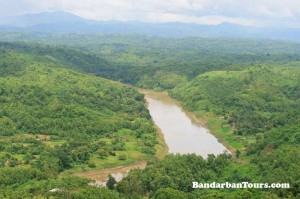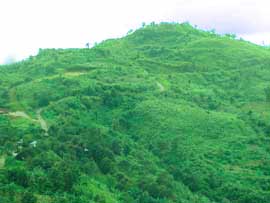The Milonchori Hillside Resort is conveniently located only 4 kilometers from Bandarban town on Chimbuk road. It includes accommodation and restaurant facilities for local and foreign tourists who wish to relax, surrounded by natural beauty, enjoy walking or trekking and are interested in visiting different indigenous peoples in the vicinity.
We provide rental services of vehicles for local movements. Our local guides are knowledgeable and will help make your excursions memorable. We have accommodation facilities for 50 persons in various categories, including air-conditioned cottages, tribal houses and dormitory. All cottages and houses have attached bathrooms, most cottages with running hot water.
The restaurant “RESTORA RIGRRE KHYANG” is located near the entrance with a breathtaking view over the rolling hills and the river below. We cater to individuals and groups of up to 100 people, making it an ideal venue for big dinner parties, seminars, and training or workshop sessions. Travel Information
How to get there:
There are direct a/c and non a/c buses of different transport operators plying between Dhaka and Bandarban in the morning and late in the evening everyday.
Other traveling options include traveling to Chittagong by bus, train or air. From Chittagong you can take a reserved transport to Bandarban. It will take about 3 hours to reach Bandarban. Suggested Activities / Destinations
Trekking to the Sangu River
To reach the Sangu River you venture on a short downhill hike. Returning to the Hillside Resort involves a physically exerting uphill climp of approximately two hours. You can opt for a local boat journey to Bandarban town and return to the resort by or reserved public or reserved transport. Shailapropat Waterfall & Bawm Village
The scenic walk to the Shailapropat waterfall (4 km from Hillside Resort) along the local road takes one hour. You may wish to take a refreshing dip in the stream or chose to continue the walk to the nearby bawm village ‘Faruk para’, before returning on foot or with local or reserved transport. For all activities we strongly recommend the assistance of a local guide. This will enhance your experience and ensure your safety. Trekking Excursion to Hatibandha
Hatibandha is a beautiful Tripura village situated in the valley close to our resort. The village can only be reached on foot. The short hike mostly follows a lovely stream, and includes some steep ascents. You will need 2-3 hours for this excursion. Excursion to Chimbuk & Murong Village
Chimbuk, one of the highest points in Bangladesh accessible by road, is an hour drive from the resort. Visitors are rewarded with a stunning view. You can also have a glimpse of Bay of Bengal from the peak. The nearby Murong tribal village is in walking distance. The accompanying guide will introduce you to the lifestyle and traditions of the Murong people. Overnight Trip Bogalake
Boga Lake is a wonderful natural lake known for its scenic beauty, 65km from Bandarban and 20 km from Ruma Thana. This overnight trip involves a two hour drive to Painkhyongchori, a boat journey to Ruma bazaar and a five hour trek to Boga Lake. Your local guide will arrange the overnight stay and all meals. You will need to carry a sleeping bag along with your essentials. Jadi Temple/ Golden Temple
Perched on a hill top in Balaghata, a few kilometers out of town, is a large, glowing Buddhist temple. It is one of the most impressive structures in the country and is worth visiting. You are not allowed to enter the temple in shorts or with shoes on. There is also a pond on the hilltop called the “Debota Pukur” meaning pond of the God. Meghla Parjatan Complex: It is located 4 km from Bandarban town, on the Bandarban-Keranihaat road. A man-made lake has been created by building a dam. Meghla houses a children’s park, a mini zoo, two hanging bridges, and has boating facilities on the lake. Nilgiri: 47 km southeast from Bandarban town, on a hilltop 2200 feet above sea-level, is situated the Nilgiri resort. It is managed and administered by the armed forces. Often covered with clouds, this place provides a panoramic view of the landscape. Bijoy/ Tajingdong: The highest peak of Bangladesh Bijoy or locally called Tajingdong has a height of about 4500 ft. It is located in Ruma upazilla. During the dry season it is possible to drive near Tajingdong by motorized vehicle. Nilachol and Shuvranila: This place is often referred to as Darjeeling of Bangladesh. Nilachol tourist centre is located 4 km from Bandarban town in a place called Tiger Para. Prantik Lake: Almost 14 km from Bandarban town, in a village called Holudia on the Bandarban-Chittagong highway, is Prantik Lake; spread over 2500 acres of land. The lake is surrounded by various species of plants and trees.
Rijuk Waterfall: On the way from Ruma to Thanchi by Shangu River you will see Ruma Jolpropat or Rijuk waterfall. You can either take an engine boat from Ruma to the waterfall or you may also go for a trekking from Ruma to Rijuk. For all activities we strongly recommend you to use the assistance of a local guide. This will enhance your experience and ensure your safety.
When visiting our Resort and its surroundings, we request you to follow these rules:
- Respect the local traditions and social rules at all times.
- Never photograph people without their permission.
- Do not encourage the illegal wildlife trade by buying endangered animals or animal products.
- Do not litter.
- Do not disturbing the wildlife and refrain from picking flowers, plants or fruits.
All foreign nationals traveling to the Hillside Resort in Bandarban need to inform the Deputy Commissioner and all the local security agencies prior to their arrival. The Guide Tours Ltd. service includes all the necessary paperwork for our international guests. We need a minimum of one week for processing permissions. The entire Chittagong Hill Tracts are malaria prone. We, therefore, strongly advise you to wear full sleeve, full pants and use insect repellent lotion, especially in the evening. During the rainy season leeches are common in this area. Suitable footwear and socks help avoid their bite. |  St. Martin's Island has become a popular tourist spot. Currently, three shipping liners run daily trips to the island, including Sea-Truck and Keary-Sindbad. Tourists can book their trip either from Chittagong or from Cox's Bazar. The surrounding coral reef of the island has an extension named Chera Dwip.
St. Martin's Island has become a popular tourist spot. Currently, three shipping liners run daily trips to the island, including Sea-Truck and Keary-Sindbad. Tourists can book their trip either from Chittagong or from Cox's Bazar. The surrounding coral reef of the island has an extension named Chera Dwip.











 In mid-15th century, a Muslim colony was founded in the inhospitable mangrove forest of the Sundarbans near the seacoast in the
In mid-15th century, a Muslim colony was founded in the inhospitable mangrove forest of the Sundarbans near the seacoast in the 



